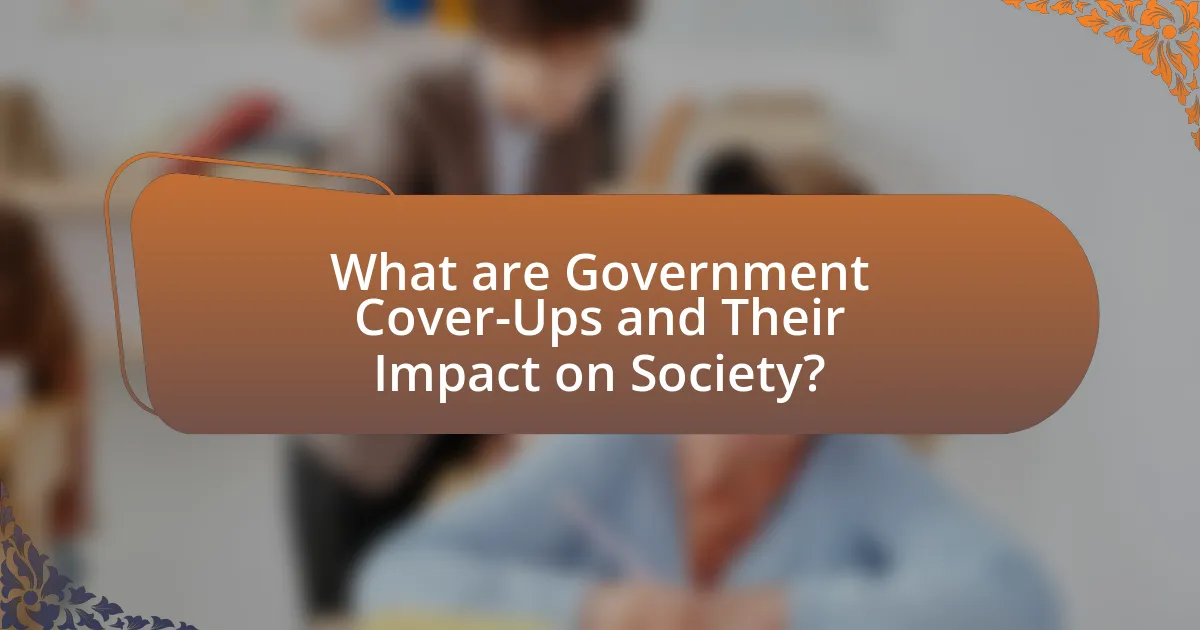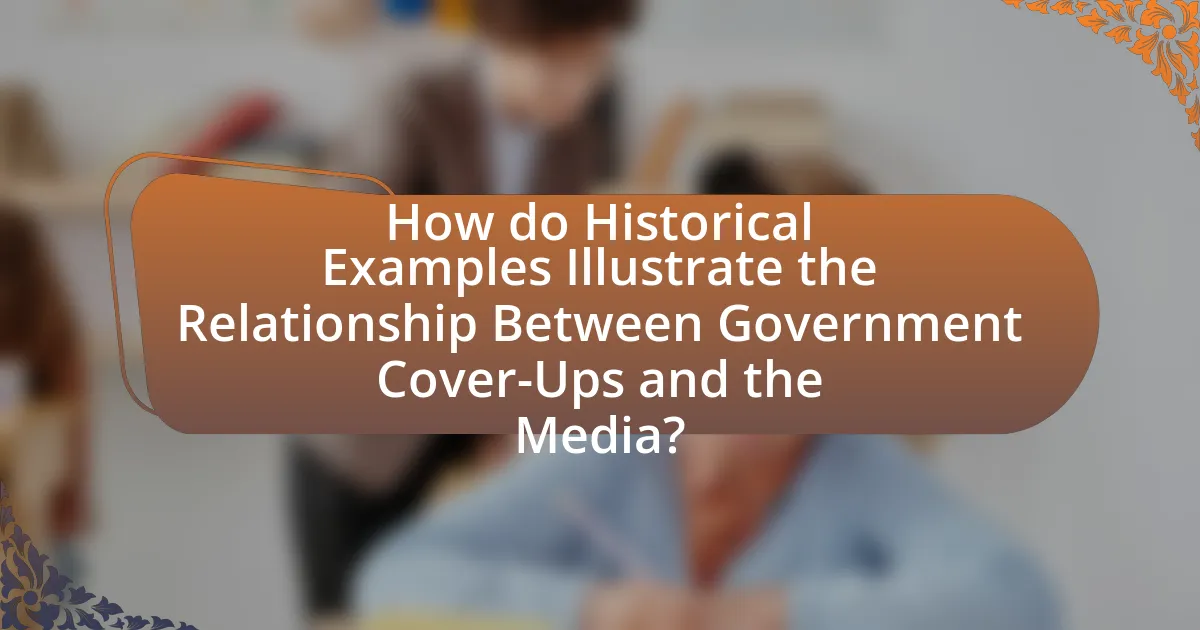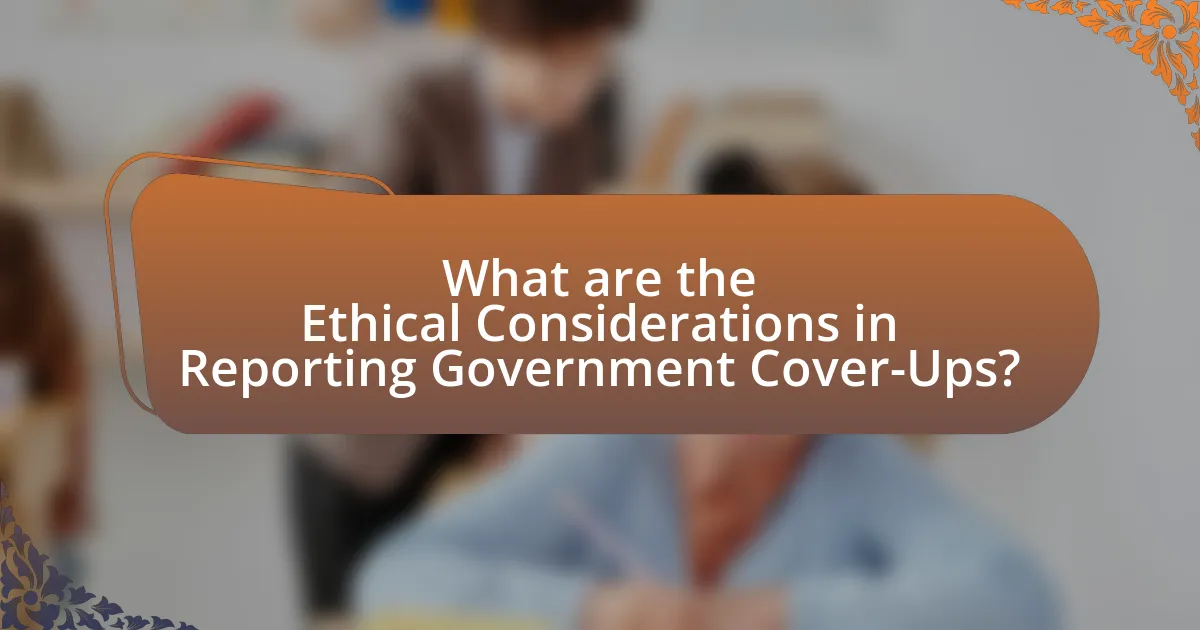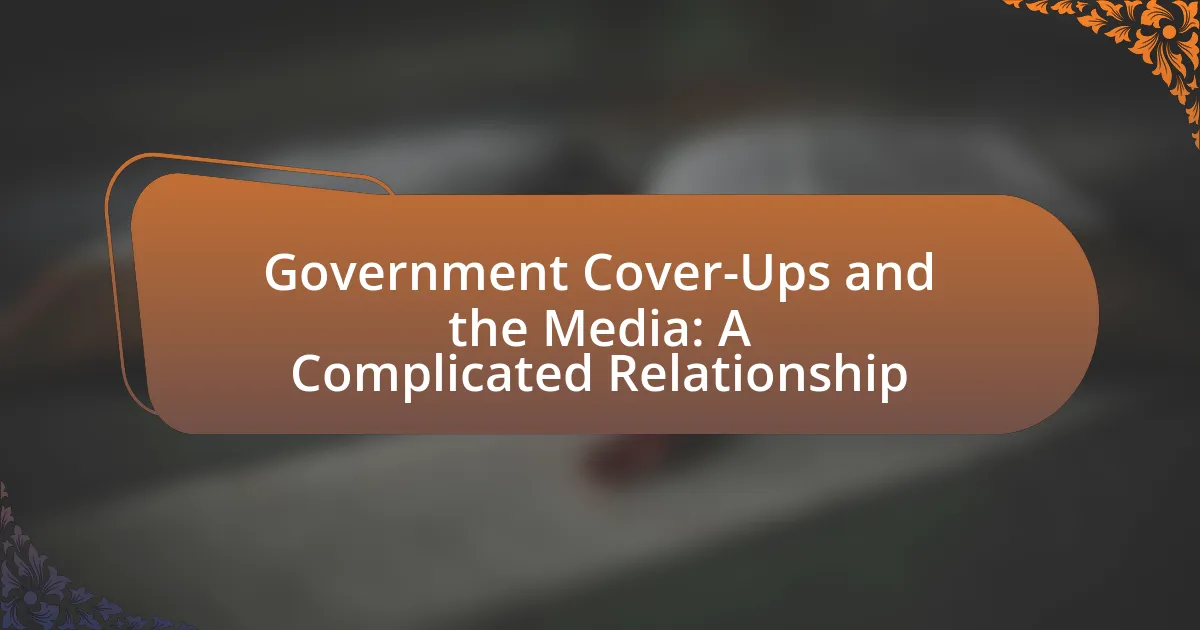Government cover-ups refer to intentional actions by authorities to hide information or actions from the public, often resulting in significant societal impacts such as distrust in government institutions. This article examines the mechanisms behind government cover-ups, their motivations, and the consequences for public trust, highlighting historical examples like the Watergate scandal and the Iran-Contra affair. It also explores the critical role of media in uncovering these cover-ups, the challenges journalists face, and the ethical considerations involved in reporting sensitive government issues. Additionally, the article discusses the influence of modern technology and social media on transparency and accountability, as well as practical steps to enhance public engagement and support for investigative journalism.

What are Government Cover-Ups and Their Impact on Society?
Government cover-ups are deliberate efforts by authorities to conceal information or actions from the public, often involving significant events or policies. These cover-ups can lead to widespread distrust in government institutions, as seen in historical instances like the Watergate scandal, where the Nixon administration attempted to hide its involvement in a break-in at the Democratic National Committee headquarters, ultimately resulting in a loss of public confidence and significant political repercussions. The impact on society includes increased skepticism towards government transparency, potential civil unrest, and a demand for accountability, as citizens become more vigilant about their rights and the actions of their leaders.
How do government cover-ups typically occur?
Government cover-ups typically occur through the deliberate concealment of information by officials to protect interests or maintain control. This process often involves the manipulation of data, suppression of evidence, and the use of misinformation to mislead the public. Historical examples, such as the Watergate scandal, illustrate how government entities can engage in systematic efforts to hide wrongdoing, often leading to significant media investigations that eventually expose the truth. The interplay between government actions and media scrutiny plays a crucial role in revealing these cover-ups, as investigative journalism can uncover hidden facts and hold authorities accountable.
What are the common motivations behind government cover-ups?
Common motivations behind government cover-ups include the desire to protect national security, maintain public order, and preserve political power. Governments often conceal information to prevent panic or unrest among the populace, as seen in instances like the Watergate scandal, where the Nixon administration sought to hide its involvement in illegal activities to maintain control. Additionally, cover-ups may occur to shield government officials from accountability, as evidenced by the Iran-Contra affair, where the Reagan administration attempted to obscure its covert operations to avoid political fallout. These motivations reflect a broader pattern of prioritizing governmental stability over transparency.
How do cover-ups affect public trust in government?
Cover-ups significantly erode public trust in government by fostering skepticism and cynicism among citizens. When governments engage in concealment of information, it creates a perception of dishonesty and a lack of accountability, leading to diminished confidence in their integrity. Historical examples, such as the Watergate scandal, illustrate this effect; public trust in the U.S. government plummeted from 77% in 1964 to 36% by 1974, demonstrating a direct correlation between governmental cover-ups and declining trust levels. This erosion of trust can result in increased public disengagement and skepticism towards future government actions and communications.
What role does the media play in uncovering government cover-ups?
The media plays a crucial role in uncovering government cover-ups by investigating and reporting on hidden information that authorities attempt to conceal. Investigative journalism often involves thorough research, whistleblower testimonies, and the analysis of documents, which can expose misconduct or corruption. For instance, the Watergate scandal was revealed through the persistent efforts of journalists Bob Woodward and Carl Bernstein, leading to significant political consequences and increased public scrutiny of government actions. This demonstrates how the media serves as a watchdog, holding government accountable and informing the public about issues that may otherwise remain undisclosed.
How do journalists investigate and report on cover-ups?
Journalists investigate and report on cover-ups by employing a combination of investigative techniques, including sourcing confidential information, conducting interviews, and analyzing public records. They often rely on whistleblowers who provide insider knowledge, as seen in cases like the Pentagon Papers, where Daniel Ellsberg leaked classified documents revealing government deception. Journalists also utilize data analysis to uncover patterns and inconsistencies in official narratives, as demonstrated in the investigation of the Watergate scandal, where reporters Bob Woodward and Carl Bernstein used meticulous research to expose corruption at the highest levels of government. Additionally, collaboration with legal experts ensures that journalists navigate the complexities of laws surrounding confidentiality and freedom of information, reinforcing the integrity of their findings.
What challenges do media face when covering government cover-ups?
Media face significant challenges when covering government cover-ups, primarily due to issues of access to information, legal threats, and public trust. Access to information is often restricted, as governments may classify documents or deny requests under freedom of information laws, making it difficult for journalists to obtain necessary evidence. Legal threats, including lawsuits or intimidation tactics, can deter media outlets from pursuing stories that may expose wrongdoing. Additionally, public trust in media can be compromised, as audiences may be skeptical of reporting that challenges government narratives, especially in politically charged environments. These factors collectively hinder the media’s ability to effectively investigate and report on government cover-ups.
Why is the relationship between government and media complex?
The relationship between government and media is complex due to the interplay of power, influence, and accountability. Governments rely on media to disseminate information and maintain public trust, while media depend on government access to information and resources for reporting. This dynamic creates tension, as governments may seek to control narratives or suppress information, leading to potential cover-ups, while media strive to investigate and expose wrongdoing. Historical examples, such as the Watergate scandal, illustrate how government secrecy can clash with journalistic integrity, highlighting the ongoing struggle for transparency and the public’s right to know.
How do government officials influence media narratives?
Government officials influence media narratives primarily through the dissemination of information and strategic communication. They often provide press releases, hold press conferences, and engage in public relations campaigns that shape the framing of news stories. For instance, during the COVID-19 pandemic, government officials in various countries utilized daily briefings to control the narrative around public health measures, influencing how media outlets reported on the crisis. This control is further reinforced by the use of official sources, which journalists often rely on for accuracy, thereby amplifying the government’s perspective. Additionally, government officials may exert influence through regulatory mechanisms, funding, or even threats of legal action against media organizations that challenge their narratives.
What are the consequences of media bias in reporting cover-ups?
Media bias in reporting cover-ups leads to misinformation and public distrust. When media outlets selectively report or distort facts, they can create a skewed narrative that misleads the audience about the true nature of events. This distortion can result in a lack of accountability for those involved in the cover-up, as biased reporting may downplay or ignore critical information. For instance, studies have shown that biased media coverage can influence public perception and diminish the likelihood of civic engagement or protest against governmental actions. Furthermore, when the public perceives media as biased, it can erode trust in journalism as a whole, making it difficult for citizens to discern fact from fiction in future reporting.

How do Historical Examples Illustrate the Relationship Between Government Cover-Ups and the Media?
Historical examples demonstrate that government cover-ups often provoke significant media scrutiny, leading to public exposure of hidden truths. For instance, the Watergate scandal in the 1970s exemplifies this relationship; investigative journalists Bob Woodward and Carl Bernstein of The Washington Post uncovered a cover-up involving President Nixon’s administration, which ultimately resulted in Nixon’s resignation. Similarly, the Pentagon Papers case in 1971 illustrated how leaked documents revealed government deception regarding the Vietnam War, prompting extensive media coverage that shifted public opinion. These instances show that when governments attempt to conceal information, the media plays a crucial role in investigating and disseminating the truth, thereby holding authorities accountable.
What are some notable historical government cover-ups?
Notable historical government cover-ups include the Watergate scandal, the Tuskegee syphilis study, and the Iran-Contra affair. The Watergate scandal involved a break-in at the Democratic National Committee headquarters in 1972 and subsequent efforts by the Nixon administration to cover it up, leading to President Nixon’s resignation in 1974. The Tuskegee syphilis study, conducted from 1932 to 1972, involved the unethical treatment of African American men who were misled about their health status and denied treatment for syphilis. The Iran-Contra affair, occurring in the 1980s, involved secret U.S. arms sales to Iran to fund Contra rebels in Nicaragua, violating congressional prohibitions. Each of these events illustrates significant breaches of public trust and ethical standards by government entities.
How did the media respond to the Watergate scandal?
The media responded to the Watergate scandal by conducting extensive investigative journalism that uncovered the details of the break-in and subsequent cover-up by the Nixon administration. Notably, journalists Bob Woodward and Carl Bernstein of The Washington Post played a crucial role in revealing the connections between the break-in and high-level officials, leading to increased public scrutiny and demands for accountability. Their reporting, which included the use of anonymous sources and meticulous fact-checking, ultimately contributed to the resignation of President Richard Nixon in 1974, marking a significant moment in American political history and demonstrating the media’s power in holding government accountable.
What lessons were learned from the Iran-Contra affair regarding media coverage?
The Iran-Contra affair highlighted the necessity for rigorous investigative journalism and the importance of skepticism in media coverage. Journalists learned that government narratives can be misleading, as the Reagan administration initially denied involvement in arms sales to Iran while secretly facilitating them. This event underscored the need for media outlets to verify information through multiple sources and to maintain a critical stance towards official statements. The affair also demonstrated the potential consequences of complacency in reporting, as early coverage often accepted government claims without sufficient scrutiny, leading to a delayed public understanding of the scandal.
How have modern technology and social media changed the landscape?
Modern technology and social media have significantly transformed the landscape of information dissemination and public engagement. The rise of platforms like Twitter and Facebook has enabled real-time communication, allowing individuals to share news and opinions instantly, which has increased transparency and accountability in government actions. For instance, the Arab Spring in 2010-2011 showcased how social media mobilized protests and exposed government actions, leading to regime changes in several countries. Additionally, the accessibility of information through smartphones and the internet has empowered citizens to challenge official narratives, making it harder for governments to conduct cover-ups without public scrutiny. This shift has fundamentally altered the relationship between the media, the public, and governmental institutions, fostering a more informed and engaged citizenry.
What role does social media play in exposing government cover-ups?
Social media plays a crucial role in exposing government cover-ups by facilitating rapid information dissemination and enabling grassroots mobilization. Platforms like Twitter and Facebook allow individuals to share evidence, such as documents or videos, that may contradict official narratives, thereby increasing public scrutiny. For instance, the Arab Spring demonstrated how social media was instrumental in organizing protests and sharing real-time updates about government actions, leading to greater accountability. Additionally, the viral nature of content on these platforms can attract media attention, amplifying the reach of whistleblowers and activists. This dynamic has been evident in various instances, such as the exposure of the NSA’s surveillance practices by Edward Snowden, where social media helped spread the revelations widely and quickly.
How has the rise of citizen journalism impacted traditional media’s role?
The rise of citizen journalism has significantly diminished traditional media’s gatekeeping role. As individuals increasingly report news through social media and personal platforms, traditional media outlets face pressure to adapt their reporting methods and speed. For instance, during events like the Arab Spring, citizen journalists provided real-time updates that traditional media struggled to match, leading to a shift in how news is sourced and disseminated. This shift has compelled traditional media to incorporate user-generated content and prioritize immediacy, thereby altering their editorial processes and diminishing their exclusive control over news narratives.

What are the Ethical Considerations in Reporting Government Cover-Ups?
Ethical considerations in reporting government cover-ups include the responsibility to ensure accuracy, the potential impact on public trust, and the need to balance transparency with national security. Journalists must verify information rigorously to avoid disseminating falsehoods, as inaccuracies can lead to misinformation and damage credibility. Additionally, exposing cover-ups can enhance public accountability but may also jeopardize sensitive information or individuals’ safety. The Society of Professional Journalists emphasizes the importance of minimizing harm while serving the public interest, highlighting the ethical dilemma of prioritizing transparency against potential risks.
What ethical dilemmas do journalists face when reporting on cover-ups?
Journalists face significant ethical dilemmas when reporting on cover-ups, primarily involving the conflict between public interest and potential harm. The obligation to inform the public about wrongdoing can clash with the risk of endangering individuals or national security. For instance, revealing sensitive information may lead to legal repercussions for the journalist or harm to whistleblowers. Additionally, journalists must navigate the challenge of verifying information while maintaining confidentiality, as sources may fear retaliation. The Society of Professional Journalists emphasizes the need for journalists to minimize harm while pursuing the truth, highlighting the complexity of these ethical decisions in the context of government cover-ups.
How do journalists balance the public’s right to know with national security concerns?
Journalists balance the public’s right to know with national security concerns by employing ethical guidelines and legal frameworks that prioritize transparency while safeguarding sensitive information. They often assess the potential impact of releasing information on public safety and national interests, weighing the benefits of disclosure against the risks of compromising security. For instance, the Society of Professional Journalists emphasizes the importance of minimizing harm, which guides journalists in making decisions about what to publish. Additionally, legal protections, such as the First Amendment in the United States, support the press’s role in informing the public, but journalists must navigate laws like the Espionage Act, which restricts the dissemination of classified information. This careful consideration ensures that while the public is informed, national security is not unduly jeopardized.
What guidelines exist for ethical reporting on sensitive government issues?
Ethical reporting on sensitive government issues is guided by principles such as accuracy, fairness, transparency, and accountability. Journalists must ensure that information is verified and presented without bias, providing context to avoid misinterpretation. The Society of Professional Journalists emphasizes the importance of minimizing harm, which includes considering the potential impact of reporting on individuals and communities involved. Additionally, the use of anonymous sources should be approached with caution, requiring a strong justification for their use to maintain credibility. These guidelines are essential to uphold journalistic integrity and public trust, particularly in the context of government cover-ups where misinformation can have significant consequences.
How can the public critically evaluate media coverage of government cover-ups?
The public can critically evaluate media coverage of government cover-ups by analyzing the sources, checking for bias, and cross-referencing information with independent investigations. Evaluating the credibility of the media outlet is essential; reputable organizations typically adhere to journalistic standards and fact-checking protocols. For instance, the Pew Research Center found that 62% of Americans believe that news organizations are often biased, highlighting the need for scrutiny. Additionally, comparing multiple reports on the same issue can reveal discrepancies and provide a more comprehensive understanding. Engaging with investigative journalism, which often uncovers hidden truths, can also enhance public awareness and understanding of government actions.
What skills are necessary for discerning credible information from sensationalism?
Critical thinking and media literacy are essential skills for discerning credible information from sensationalism. Critical thinking enables individuals to analyze and evaluate the validity of information by questioning sources, assessing evidence, and recognizing biases. Media literacy involves understanding how media messages are constructed and the techniques used to influence audiences, which helps individuals identify sensationalist tactics. Research indicates that individuals with strong critical thinking and media literacy skills are better equipped to differentiate between factual reporting and sensationalized content, as they can scrutinize the intent behind the information presented.
How can individuals support investigative journalism in the face of cover-ups?
Individuals can support investigative journalism in the face of cover-ups by financially contributing to independent media organizations and investigative projects. Funding allows these entities to conduct thorough investigations that may expose corruption and misconduct, as seen with organizations like ProPublica, which relies on donations to produce in-depth reporting. Additionally, individuals can share investigative articles on social media platforms to increase visibility and public awareness, thereby pressuring authorities to address the issues highlighted. Engaging in community discussions about the importance of transparency and accountability also fosters a culture that values investigative journalism, as evidenced by the rise in public support for media initiatives during high-profile scandals.
What practical steps can be taken to improve transparency and accountability?
To improve transparency and accountability, governments can implement open data initiatives that require the public release of government data and decision-making processes. These initiatives enhance public access to information, allowing citizens to scrutinize government actions and hold officials accountable. For instance, the U.S. government’s Data.gov platform provides access to a vast array of government datasets, promoting transparency. Additionally, establishing independent oversight bodies can ensure that government actions are monitored and reported, further enhancing accountability. Research indicates that countries with strong oversight mechanisms, such as the United Kingdom’s National Audit Office, experience higher levels of public trust and accountability in government operations.
